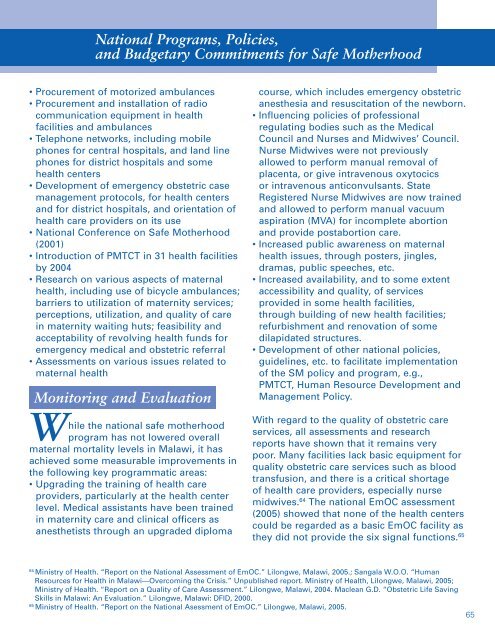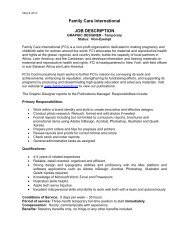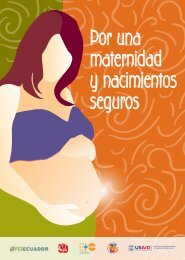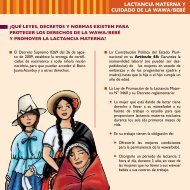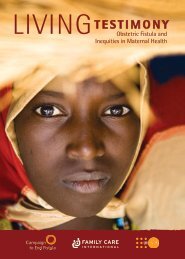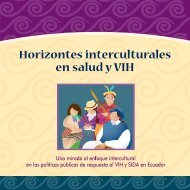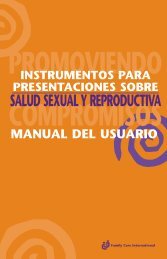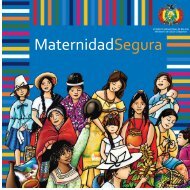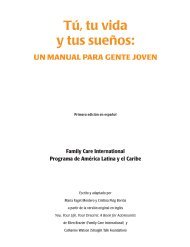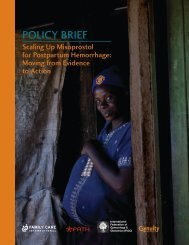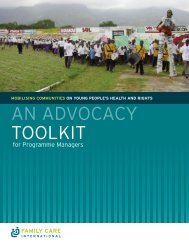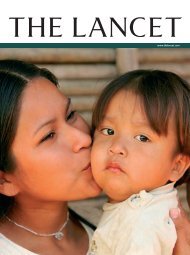Safe Motherhood: A Review - Family Care International
Safe Motherhood: A Review - Family Care International
Safe Motherhood: A Review - Family Care International
You also want an ePaper? Increase the reach of your titles
YUMPU automatically turns print PDFs into web optimized ePapers that Google loves.
National Programs, Policies,<br />
and Budgetary Commitments for <strong>Safe</strong> <strong>Motherhood</strong><br />
• Procurement of motorized ambulances<br />
• Procurement and installation of radio<br />
communication equipment in health<br />
facilities and ambulances<br />
• Telephone networks, including mobile<br />
phones for central hospitals, and land line<br />
phones for district hospitals and some<br />
health centers<br />
• Development of emergency obstetric case<br />
management protocols, for health centers<br />
and for district hospitals, and orientation of<br />
health care providers on its use<br />
• National Conference on <strong>Safe</strong> <strong>Motherhood</strong><br />
(2001)<br />
• Introduction of PMTCT in 31 health facilities<br />
by 2004<br />
• Research on various aspects of maternal<br />
health, including use of bicycle ambulances;<br />
barriers to utilization of maternity services;<br />
perceptions, utilization, and quality of care<br />
in maternity waiting huts; feasibility and<br />
acceptability of revolving health funds for<br />
emergency medical and obstetric referral<br />
• Assessments on various issues related to<br />
maternal health<br />
Monitoring and Evaluation<br />
While the national safe motherhood<br />
program has not lowered overall<br />
maternal mortality levels in Malawi, it has<br />
achieved some measurable improvements in<br />
the following key programmatic areas:<br />
• Upgrading the training of health care<br />
providers, particularly at the health center<br />
level. Medical assistants have been trained<br />
in maternity care and clinical officers as<br />
anesthetists through an upgraded diploma<br />
course, which includes emergency obstetric<br />
anesthesia and resuscitation of the newborn.<br />
• Influencing policies of professional<br />
regulating bodies such as the Medical<br />
Council and Nurses and Midwives’ Council.<br />
Nurse Midwives were not previously<br />
allowed to perform manual removal of<br />
placenta, or give intravenous oxytocics<br />
or intravenous anticonvulsants. State<br />
Registered Nurse Midwives are now trained<br />
and allowed to perform manual vacuum<br />
aspiration (MVA) for incomplete abortion<br />
and provide postabortion care.<br />
• Increased public awareness on maternal<br />
health issues, through posters, jingles,<br />
dramas, public speeches, etc.<br />
• Increased availability, and to some extent<br />
accessibility and quality, of services<br />
provided in some health facilities,<br />
through building of new health facilities;<br />
refurbishment and renovation of some<br />
dilapidated structures.<br />
• Development of other national policies,<br />
guidelines, etc. to facilitate implementation<br />
of the SM policy and program, e.g.,<br />
PMTCT, Human Resource Development and<br />
Management Policy.<br />
With regard to the quality of obstetric care<br />
services, all assessments and research<br />
reports have shown that it remains very<br />
poor. Many facilities lack basic equipment for<br />
quality obstetric care services such as blood<br />
transfusion, and there is a critical shortage<br />
of health care providers, especially nurse<br />
midwives. 64 The national EmOC assessment<br />
(2005) showed that none of the health centers<br />
could be regarded as a basic EmOC facility as<br />
they did not provide the six signal functions. 65<br />
64 Ministry of Health. “Report on the National Assessment of EmOC.” Lilongwe, Malawi, 2005.; Sangala W.O.O. “Human<br />
Resources for Health in Malawi—Overcoming the Crisis.” Unpublished report. Ministry of Health, Lilongwe, Malawi, 2005;<br />
Ministry of Health. “Report on a Quality of <strong>Care</strong> Assessment.” Lilongwe, Malawi, 2004. Maclean G.D. “Obstetric Life Saving<br />
Skills in Malawi: An Evaluation.” Lilongwe, Malawi: DFID, 2000.<br />
65 Ministry of Health. “Report on the National Asessment of EmOC.” Lilongwe, Malawi, 2005.


